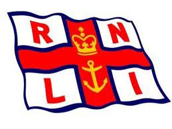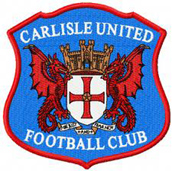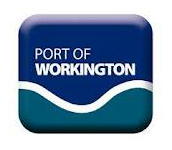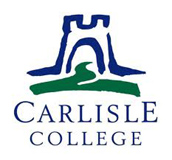- Home
- Scarrows
- Mariners
- Cumberland
- Miscellaneous
Carlisle, History and Old Photographs
Carlisle from Stanwix
Roman Carlisle
Carlisle began as a Roman town called Luguvallium. The Romans invaded Britain in 43 AD and about 78 AD the governor, Agricola, built a wooden fort on the site of Carlisle. Soon a civilian settlement grew up nearby. The soldiers in the fort provided a market for the townspeople's goods.
In Roman Carlisle there was probably a forum or market place with the public buildings around it. There was also a public baths - in Roman times people went to the baths not just to get clean but also to socialise. In the 4th century Roman civilisation declined, with troops being withdrawn from Hadrian's wall in 399 AD - the last Roman soldiers left Britain in 407. Soon afterwards the Roman way of life broke down and most Roman towns were abandoned.
Carlisle from the 5th to the 11th Century
Carlisle may not have been abandoned completely - there may have been some farmers living inside the walls and farming the land outside. However it seems certain that Carlisle ceased to be a town and all of its Roman buildings fell into ruins. Carlisle was part of the Celtic kingdom until the 7th century when it fell to the Saxons. It was the Celts gave Carlisle its name - they called it Caer Luel, the fortified place belonging to Luel. St Cuthbert founded a monastery among the ruins of Carlisle in 685.
In 876 the Vikings captured Carlisle and sacked it. The monks moved away but some people probably continued to live within the walls of the old Roman town. The Vikings held Carlisle until the 10th century when the Saxons once again captured it. Carlisle was rebuilt and revived by King William Rufus in 1092. He built a wooden castle at Carlisle which was rebuilt in stone in the 12th century.

Carlisle Cathedral
Carlisle in the Middle Ages
In the Middle Ages Carlisle was a small town with a population of between 1,500 to 2,000. It would seem tiny to us, but by the standards of the time, Carlisle was a fair-sized market town. Cumbria was a poor area of England with little trade and commerce in the region. However Carlisle was strategically important because of its position near the Scottish border, and in the 12th century, stonewalls were erected around the town. The castle was rebuilt in stone and strengthened at this time. Nevertheless between 1135 and 1154 Carlisle was in the hands of the Scots. The Scots again laid siege to Carlisle for 3 months in 1173 but this time they were unable to take the town. The Scots returned in 1315 but yet again they were unable to capture Carlisle.
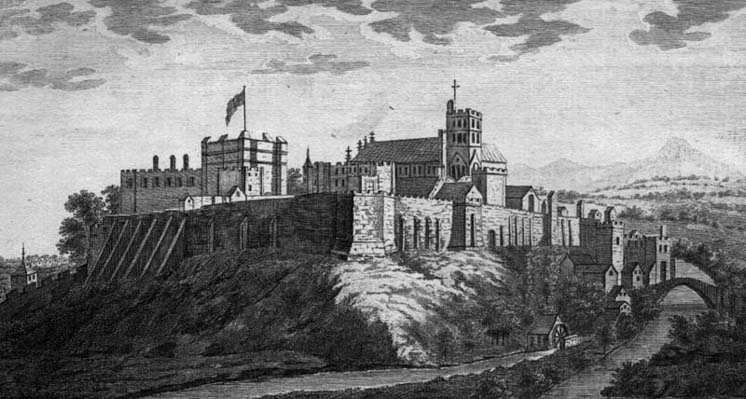
Carlisle Castle
In 1122 a priory (small monastery) was built in Carlisle and in 1133 Carlisle was made the seat of a bishop. In 1223 the friars arrived in Carlisle - the friars were like monks but instead of withdrawing from the world they went out to preach. There were two orders of friars in Carlisle, the Dominicans (called black friars because of their black costumes) and the Franciscans or grey friars. Carlisle was given its first charter in 1158 - a charter was a document granting the townspeople certain rights.
In Carlisle the main industries were wool and leather - wool was woven and dyed in the town and leather was tanned. Wool and leather were exported to Ireland and wine, the drink of the upper class, was imported from France. Carlisle had a weekly market and an annual fair. People would come from all over Cumbria to buy and sell at a Carlisle fair. In 1292 Carlisle suffered a disastrous fire - most of the buildings in Carlisle were of wood with thatched roofs so fire was a constant danger, but on the other hand if buildings did burn they could be easily replaced.
In Carlisle different trades were organised into guilds to safeguard their member's interests. There were eight of them: merchants, butchers, skinners, shoemakers, tanners, tailors, smiths and weavers. In the early 15th century a Guildhall was built where they could hold meetings. In 1349 the Black Death devastated the population of Carlisle, and it did not recover fully until the 16th century.
Carlisle in the 16th and 17th Centuries
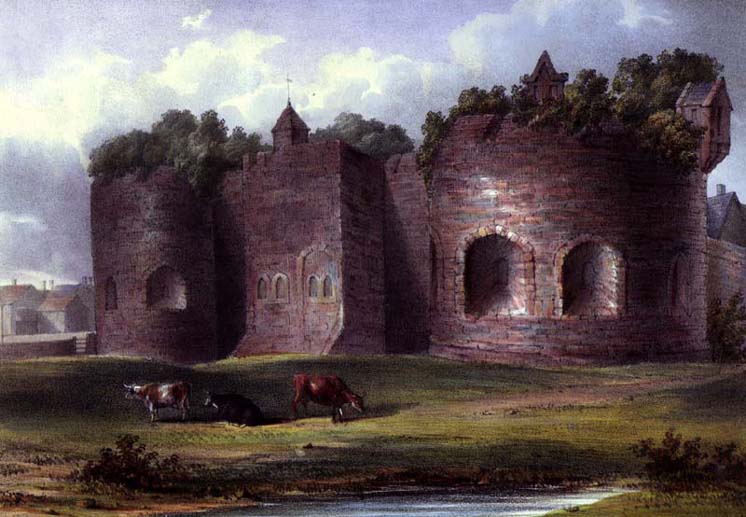
Carlisle City Walls and Citadel
In 1541 Henry VIII closed the priory and the two friaries. He also rebuilt and strengthened the castle, and replaced the southern gate of Carlisle with a citadel with two towers. Like all towns in those days Carlisle suffered outbreaks of plague which decimated the population each time and one such occurred in Carlisle in 1597. Even so the population grew, and by 1600 Carlisle had about 2,500 inhabitants. In 1642 came civil war between king and parliament with Carlisle being staunchly loyal to the king. After the battle of Marston Moor in July, Scottish soldiers (on parliament's side) occupied all of northern England except Carlisle. The city was under siege from October 1644 to June 1645 when finally Carlisle was starved into surrender. The soldiers then ransacked and vandalised the Cathedral, and afterwards Carlisle was again struck by an outbreak of plague which killed many people. Carlisle Cross was erected in 1682, Tullie House was built in 1689, and the Old Town Hall was built in 1699.
Carlisle in the 18th Century
In 1745 the Jacobites under their leader Bonnie Prince Charlie marched south and after a short siege took Carlisle. However they did not hold it for long. English forces soon recaptured Carlisle. They hanged several Jacobites.
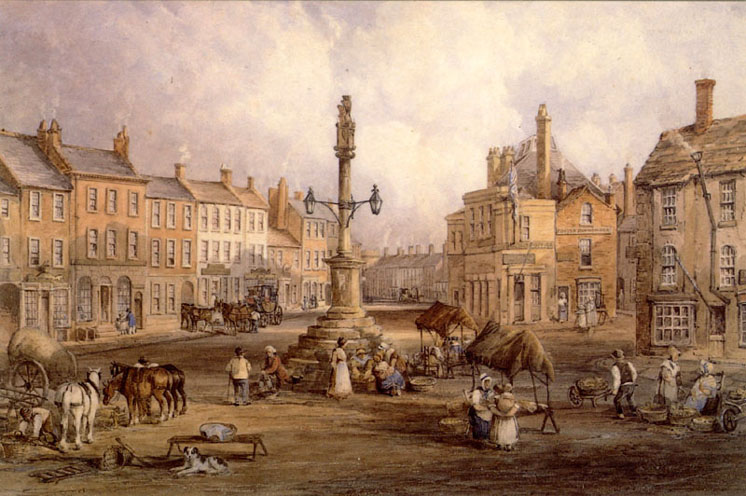
Carlisle Market and Cross
In the mid-18th century Carlisle was no more than a medium sized market town with a population of about 4,000, but the situation began to change in the late 18th century. Trade had always been limited in Carlisle because it was in a poor area of England, but the latter part of the 18th century roads to and from Carlisle were improved, which allowed the merchants of the town to sell their goods elsewhere - in 1758 a turnpike road was build to Newcastle. In the last years of the 18th century the industrial revolution began to transform Carlisle. The wool industry began to boom, St Cuthbert's Church was built in 1778 and in 1782 a dispensary opened where the poor could obtain free medicines. Carlisle gained its first bank in 1787 and its first newspaper in 1798.
Carlisle in the 19th Century
In 1801 the population of Carlisle was 9,555 - by the standards of the time it was quite a large town. Carlisle grew rapidly and by 1851 it had a population of over 25,000, swelled by Scottish and Irish immigrants. The textile industry boomed in the early 19th century, although many of the weavers lived in poverty, but in the later 19th century the industry had declined. Other industries in Carlisle in the 19th century were biscuit making, engineering, printing and brick making. From 1804 the corporation lit and paved the streets - at first Carlisle was lit by oil lamps but after 1819 it was lit by gas. Carlisle gained its first theatre in 1813, and first infirmary in 1841. Between 1811 and 1815 parts of the town walls were demolished, with Lowther Street being laid out on the site of the east wall.
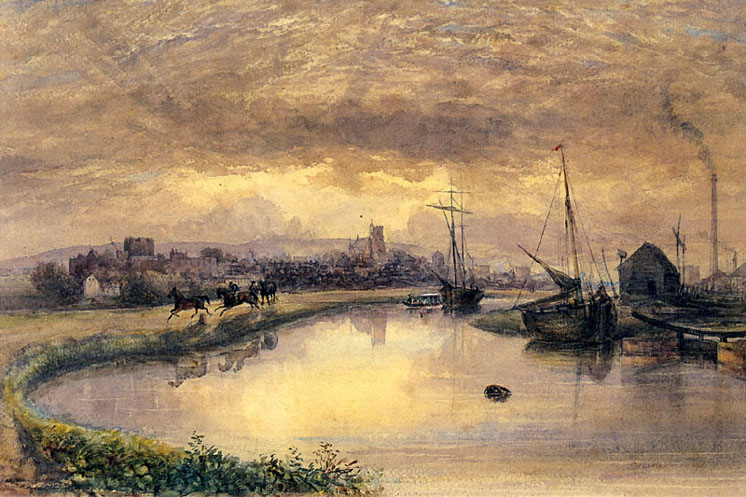
Carlisle Canal
Like all towns in the early 19th century, Carlisle was dirty and unsanitary -there were outbreaks of cholera in 1832 and 1848. In 1848 a company began to supply piped water (to those who could afford it), and in the 1870s sewers were dug under Carlisle. The first telephone exchange in Carlisle opened in 1885.
In 1893 a park was opened called the Peoples Park - it was later extended and renamed The Bitts. In 1899 electricity was generated in Carlisle for the first time and the town gained electric light. In 1823 a canal was dug from Carlisle to Port Carlisle, but was filled in 30 years later. In 1856 a railway was built to replace it - a railway connected Carlisle to Newcastle in 1838, to Maryport in 1845, another connected Carlisle to Lancaster in 1846. The Citadel station was built in 1848.

